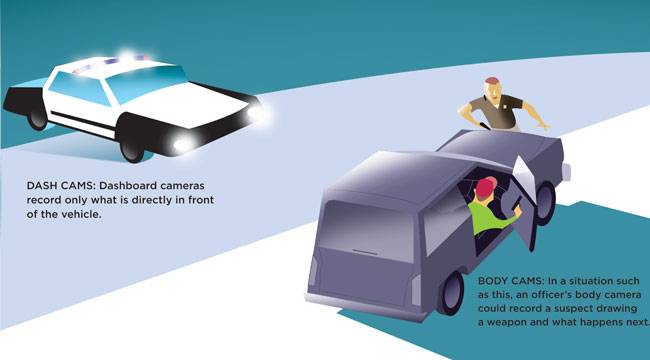
Monday, Feb. 9, 2015 | 2 a.m.
After the deaths of an unarmed teenager in Ferguson, Mo., and a man in Staten Island, N.Y., both at the hands of police, law enforcement officials across the country increasingly are looking at body cameras as a way to enhance officer transparency and accountability. Metro Police officials announced plans for a camera pilot program in 2013, well before the deaths of Michael Brown and Eric Garner. The department, which has faced accusations of racial bias after a series of officer-involved shootings in the 2000s, hopes body cameras will help improve community relations.
WHAT ARE BODY CAMERAS?
Tiny video cameras mounted directly onto a person to capture footage from the wearer’s point of view, body cameras typically are worn by police but are marketed for athletes and adventure seekers who want to capture action shots, as well.
HOW THEY WORK
• Metro’s cameras are no bigger than a marker and have a magnetic strip that allows officers to attach them to mounts placed on their shoulder, collar or head, or on a pair of glasses.
• Most officers prefer the collar because it’s the most comfortable. The least popular option is the head because it slips and officers say it looks goofy. The cameras are sturdy and are designed to stay on an officer during a struggle or foot chase.
• Cameras come with a battery pack about the size of a deck of cards. The camera’s power switch is on the battery pack, connected by a thin wire.
• Footage is stored on a chip inside the battery pack. A dock at the police station uploads the data to a computer.
• Cameras can record audio, but police have to activate that function manually.
GETTING STARTED
Metro began buying cameras in March, and the yearlong pilot program began officially in November. Of Metro’s 2,555 officers, 197 volunteered to wear body cameras.
Another 190 officers not wearing cameras also will be studied
COSTS
• Each body camera costs about $500.
• The infrastructure to support the cameras — the wiring, software and video archive system — costs much more. Just the docks cost $55,000 to buy and install.
• Metro’s body camera study will cost $1.6 million, with the bulk of the money going toward software and wiring.
• The U.S. Department of Justice gave Metro a $107,000 grant to help offset the cost, and local officials are trying to secure another $95,000 grant. But most of the program’s cost will come from Metro’s budget.
• In December, President Barack Obama pledged $263 million to procure body cameras and training for up to 50,000 police officers nationally.
WHAT ABOUT DASH CAMS?
Henderson and Boulder City police, as well as the Nevada Highway Patrol, use dash cameras in vehicles. Metro does not.
The cameras are mounted inside officers’ vehicles and can record video while the officer is driving. They have been widely available since the 1980s.
Like body cameras, they can enhance officer safety and improve accountability, advocates say. The biggest concern users have had is the cameras’ poor sound quality. Police who frequently are on foot also don’t benefit much from the cameras since the devices capture only action directly in front of the vehicle.
• All 150 Henderson Police patrol cars have been outfitted with dash cameras since June 2011. The cameras turn on automatically when an officer’s vehicle goes 80 mph or faster, when an officer manually activates one or when a patrol car’s sirens are turned on. The cameras can’t be turned off manually. A $1.2 million grant from the U.S. Justice Department paid for the equipment.
• Dash cameras in Boulder City cost about $3,500 each. Each of the department’s 28 patrol cars has a camera
WHO CAN SEE THE FOOTAGE?
• Police. Supervisors overseeing the pilot program can view footage. Officers can see only the footage they upload.
• Lawyers. Prosecutors and defense attorneys can request footage, which is admissible in court. Experts say courts, arbitrators and civilian review boards increasingly expect police to use body cameras.
• Body camera footage typically isn’t available to the public while it’s part of an open investigation.
• Of the 40,000 recordings Metro Police have made so far, officials have retained fewer than half, they said. Officers delete footage from calls that don’t result in criminal charges. All other footage is kept for at least 45 days.
SCOPE
• Metro is the only Southern Nevada law enforcement agency that uses body cameras. North Las Vegas, Henderson, Boulder City and Clark County School District police say they have considered using body cameras but are awaiting the results of Metro’s study.
• About a quarter of police departments nationally use body cameras, according to a 2013 study by the U.S. Justice Department.
• More than 1,200 law enforcement agencies have bought wearable cameras from Taser International, one of the devices’ primary distributors.
FOOTAGE WORKS BOTH WAYS
• Camera footage helped quell unrest in Rialto, Calif., after police shot and wounded a man in 2011. The man claimed he was unarmed, but footage from a camera the officer was wearing on his uniform showed the suspect waving a handgun.
• In 2012, after Rialto police equipped more officers with cameras, complaints of police abuse plummeted from 24 to three in the first year. Incidents of police use-of-force dropped by 66 percent.
• An officer in Phoenix was fired after footage from his body camera showed him repeatedly verbally abusing people, using profanity and making threats against the public.
Chris Morris created the graphics for this story.

Join the Discussion:
Check this out for a full explanation of our conversion to the LiveFyre commenting system and instructions on how to sign up for an account.
Full comments policy